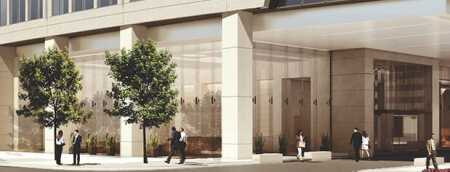Like a sweltering summer day in the Panhandle, the Texas real estate market is hot. Very hot.
The Lone Star State has not only recovered from the economic downturn of a few years ago, but also has surged further ahead. Low unemployment, high job growth, an educated workforce, and unceasing efforts to lure business to the state continue to drive real estate markets higher.
Nearly all real estate sectors—commercial, multifamily, residential, and industrial—in Austin, San Antonio, Houston, and Dallas/Fort Worth, are healthy, says Denise A. Green, a partner in the San Antonio office of national accounting firm BKD.
“The state’s strong population growth and sub–6 percent unemployment will mean that overall development demand should continue to be robust,” she says. “Texas once again dominated Forbes magazine’s list of America’s fastest-growing cities, capitalizing on low taxes and cheap real estate to draw in jobs from the rest of the country. Forbes’s list puts Austin at number one, Dallas at number two, Houston at number four, and San Antonio at number nine. While multifamily has led the development charge, industrial development also will be very strong this year.”
Powering the Texas real estate surge is an abundance of money. Capital, both debt and equity, is increasingly attracted to Texas, and that is unlikely to change in 2014, says John Morran, principal at Austin’s Texas Realty Capital, a commercial mortgage banking and real estate investment advisory services firm. “Competition for deals is high, and pricing and terms are driving valuations that are setting records in certain locations and property types,” he says. “Some construction lenders—and equity investors—are starting to become more cautious on new projects in submarkets where there are several new projects already out of the ground. A pause in the appetite to capitalize new construction projects in these submarkets is likely until these projects deliver and prove up their leasing.”
Austin
In the state capital, Austin, for example, the single-family housing, multifamily rental, hospitality, and downtown office segments are all very hot, and the retail, restaurant, industrial, medical, and residential condominium sectors are heating up, says Eric Van Hyfte, senior associate in the Austin office of Dallas-based architecture and planning firm BOKA Powell.
“People and companies want to move here,” he says. “Austin continues to add to its reputation as a sports, music, and cultural mecca as the new home of Formula 1 racing and ESPN’s summer X Games showcasing action sports. That’s in addition to homegrown film festivals and conferences like South by Southwest, the music event Austin City Limits, and the Fun Fun Fun Fest—independent festivals for music lovers and music makers—which continue to grow.” Indeed, the city refers to itself as the Live Music Capital of the World.
Earlier this year, BOKA Powell completed RiverView, a 302-unit multifamily luxury high-rise complex on Lady Bird Lake, and construction continues on Lamar Union, a residential/retail mixed-use project south of downtown, designed for Greystar Real Estate Partners. “We are currently working with four separate developers with plans for high-rise residential towers in the design or planning stages, plus a high-design, boutique hotel/condo project on Austin’s burgeoning east side,” Van Hyfte adds.

BOKA Powell designed Granite Park IV, a 12-story, 300,000-square-foot (28,000 sq m) Class A office tower in Plano. A development of Granite Properties, the structure is being built to achieve LEED Silver certification. It was designed by BOKA Powell to appeal to the next-generation office worker who does not work exclusively at a desk. (Boka Powell)
Austin also has benefited from several major employers who relocated or expanded their presence there, including Apple, HID Global, Visa, Dropbox, and Athenahealth, says Morran.
The city’s ability to draw major employers and nurture entrepreneurs and innovators means another strong period of real estate growth, says Philip Crisara, executive vice president of locally based architecture and planning firm Nelsen Partners. “That ability has created a steady increase in demand for an educated workforce that has driven residential growth and that shows no sign of slowing,” he says. “Austin’s vibe is alive and well, sitting at the top of many national rankings for the city’s quality of life, job opportunities, growth, technology, and education. These facts have translated into demand and delivery of additional office space and a variety of residential products in both downtown Austin and its suburban markets.”
Among the Nelsen Partners projects under construction or currently in design is Endeavor Real Estate Group’s 176-acre (71 ha) portion of the Domain in north Austin, Crisara says. Endeavor is currently building a six-story, 230,850-square-foot (21,447 sq m) Class A office building and attached 840-car garage at the development, he says, and a six-story, 213,000-square foot (19,800 sq m) Class A office building with an attached 794-car garage is in design.

Levinson Alcoser Associates is the architect for Fidelis Realty Development’s 500,000-square-foot (46,000 sq m) Tanglewood Court in Houston. The mixed-use, urban-styled development includes an HEB supermarket, multitenant shops, and a 430-unit mid-rise residential tower. (Patrick y. Wong/Atelier Wong)
Houston
The real estate frenzy is not limited to Austin. Houston is one of the best real estate markets in the country for new construction and redevelopment of inner-city sites, says Lawrence S. Levinson, principal and founder of Houston-based architecture firm Levinson Alcoser Associates.
“Houston’s strong energy-sector growth, along with a favorable state business environment, is fueling development,” he notes. “We are seeing solid growth in all major building types in Houston. The most visible is multifamily, largely because of the low inventory and availability of financing. On the industrial side, the growth of the energy industry, the Port of Houston, and an efficient rail and truck transportation networking system is fostering a swell of activity from U.S. and international companies.”
Houston has made noticeable progress in economic diversification, though its economy continues to be largely driven by energy and energy-related business, says Jason Mattox, chief operating officer of Behringer, a Dallas-based investment company that creates, manages, and distributes alternative investment programs, including real estate investment trusts (REITs). “The current price of oil and resurgence of domestic exploration and production should help Houston maintain a healthy growth trajectory and positively influence the real estate market in all sectors,” says Mattox.

In August 2013, Behringer Harvard Opportunity REIT II acquired Parkside Apartments, a 240-unit garden apartment community in Sugar Land, an affluent and rapidly growing city 20 miles (32 km) southwest of downtown Houston. The 240-unit complex includes 19 two- and three-story residential buildings. (Behringer Harvard Opportunity REIT II Inc.)
Earlier this year, Behringer Harvard Opportunity REIT II acquired Parkside Apartments in Sugar Land, a distant Houston suburb, partnering with a Houston-based operator. “Unlike inner Houston, Sugar Land has a limited supply of multifamily housing and provides its residents with an exceptional school system,” says Mattox. “Since Behringer Harvard Opportunity REIT II acquired Parkside Apartments, we have been pleased with the property’s performance. We expect its strong performance to continue.”
Behringer examines investment opportunities in Houston and all major Texas markets, he adds. “Competition for assets in core markets continues to increase, causing some investors to shift their focus to secondary markets,” says Mattox. “Although our orientation continues to be toward core markets, we also evaluate unique opportunities in secondary markets that are particularly attractive.”
Job creation and strong economic activity in Houston are spurring activity in various sectors, including retail. Levinson Alcoser Associates is the architect on Fidelis Realty Development’s 500,000-square-foot (46,000 sq m) Tanglewood Court, an inner-city infill development between two affluent Houston neighborhoods that is expected to be completed this summer. “It’s a mixed-use, urban-styled development that includes a new HEB supermarket, a multitenant retail and restaurant building, a bank, and a 430-unit mid-rise residential tower,” says Levinson.
San Antonio
The Alamo City is also reporting robust real estate activity, says Charles S. Teeple IV, chairman of Teeple Partners in Austin. “Teeple Partners completed construction of the 328-unit luxury garden apartment development Bulverde Oaks in north San Antonio in March and closed on a 276-unit value-added project in west San Antonio earlier this year that will be refurbished,” Teeple says. “We are also active in San Antonio’s city center, renovating 50,000 square feet [4,645 sq m] of historic buildings—preserving the old while planning for the new in a sustainable way that provides positive benefits.”

BOKA Powell was architect of record for the $325 million, 1,001-room Omni Dallas Hotel, which is connected to the Kay Bailey Hutchison Convention Center. The hotel’s illuminated facade has become a canvas for multimedia art. BOKA Powell is working on a restaurant and expansion. (Erika Brown Edwards/Urban Fabric Photography)
Teeple is forecasting another robust year for Texas real estate, based on a presumption that the state will continue to lead the country in job creation and immigration of people from other states. “Both the multifamily and office markets should continue to improve next year,” he says. “Although there are specific submarkets with oversupply issues and increasing construction costs are impacting profitability, development levels in Texas should remain above average.”
Investors with cash looking for opportunities are driving the state’s real estate markets, says BKD’s Green. “There is a lot of new capital, including private equity funding, that is now available here,” she explains. “As the gateway markets such as New York City and San Francisco get picked over and returns go down, we will see more outsiders looking at investing in Texas. We are also seeing the resurgence of mezzanine lenders offering good terms. Texas has also established a state tax credit for the rehabilitation of historic buildings, which makes us competitive with other states.”
Dallas/Fort Worth
The Dallas/Fort Worth Metroplex real estate market is also exceptionally strong. Rents are up and vacancies are low in most sectors, says Mark Sikes, principal in the real estate valuation and consulting firm Deal Sikes & Associates. “We are seeing a spate of office building construction across the Dallas/Fort Worth area,” he says. “Office vacancy rates are at ten-year lows in many submarkets. The office market is tight in Las Colinas, downtown Fort Worth, and other desirable suburban submarkets.”
Like Austin, the Dallas/Fort Worth region is projected to experience continued strong job growth, translating into impressive gains in the north Texas commercial real estate market, says Sikes. “Property values in the DFW Metroplex generally have been on an upward trend since the end of the recession, and we expect that to continue over the next year. Some of the gains will be remarkable,” he predicts.
BOKA Powell completed the 500,000-square-foot (47,000 sq m) expansion of Southwest Airlines’ Dallas headquarters earlier this year, and ground is being broken on several other developments. These include high-profile office projects such as Bandera Ventures’ 8111 Westchester commercial office development in Preston Center; Granite Properties’ Granite Park IV, a 300,000-square-foot (28,000 sq m) office tower at Granite Park in Plano; and Alliance Town Center Office North in the AllianceTexas development in Fort Worth for Hillwood, an industrial, commercial, and residential real estate development company founded by Ross Perot Jr.
In the hospitality sector, BOKA Powell completed design of the 299-room Hilton Dallas/Plano Granite Park hotel, says Don Powell, a principal with BOKA Powell. The firm also is working with the Neal Richards Group on a new surgical hospital, Forest Park Medical Center, in San Antonio. “Our higher-education practice is engaged with Texas A&M University’s flagship College Station campus and Balfour Beatty Campus Solutions in a public/private partnership to deliver 4,000 beds in apartments and student housing and a campus commons/dining facility,” adds Powell.
Strong real estate markets in Houston and throughout Texas are not providing many prospects for opportunity investors, says L. Andy Mitchell, president of Lantern Asset Management, a commercial real estate asset management firm based in Dallas. “Texas performed well during the recent financial turmoil, so the state has far less real estate distress than other parts of the country,” he notes. “Value-add opportunities have been few and far between, with seller valuation expectations that make such investing difficult. Texas real estate brokers are doing a great job, to the disappointment of investors looking for below-market assets.”
Lantern is evaluating other opportunities in the state where improved management and additional capital may be needed to unlock asset value. “Real estate is still a local business, and we seek partnerships with local business leaders to create sustainable investments that are good both for our investors and the local economy,” Mitchell says.
While the Texas real estate market is extremely active now, few expect the trend to continue indefinitely. Fundamentals in Texas have been in a relatively prolonged upward phase of the real estate cycle, notes Mattox, who adds that this trend warrants caution and vigilance. “Growing supply and Houston’s historic lack of zoning in many submarkets, for instance, could contribute to sharp turns ahead in market fundamentals,” he adds. “Overall, though, Houston still has many pockets for intriguing investment opportunities.”
The outlook for Texas real estate continues to be strong, particularly with the state leading the country in job and population growth. “The result for commercial real estate has been strong property fundamentals—increasing occupancy levels and rent growth in all sectors,” says Morran. “The question for 2014 will be whether the demand for new space keeps up with the supply that is coming from new construction. The lack of construction between 2008 and 2012 has created a market that needs new supply, but with the number of new projects that have come out of the ground since the second half of 2012, the question will be how quickly will the market absorb the new space.”
Mike Sheridan is a freelance writer in Parsippany, New Jersey.









